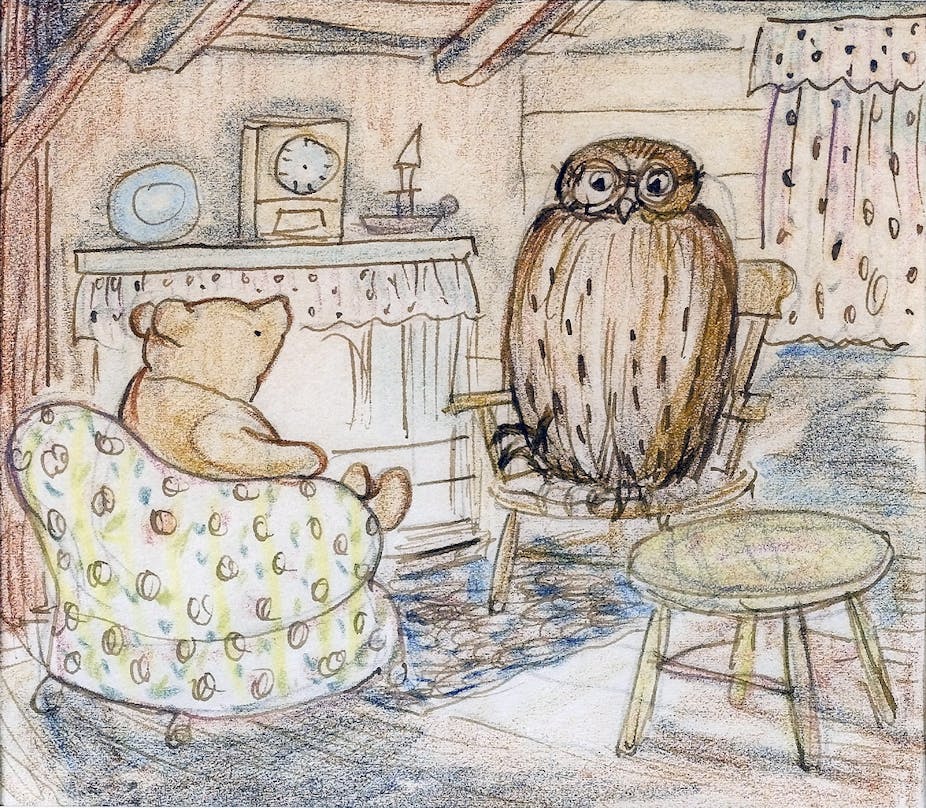In children’s literature, a small number of classics are remembered for their illustrations as much as they are for the author’s words. Sir John Tenniel’s original drawings for Lewis Carroll’s “Alice” books are, for many readers, impossible to disentangle from the text. Roald Dahl’s stories have become almost inseparable from Quentin Blake’s pictures, and Thomas Henry’s images of William defined him as succinctly as the writing of Richmal Crompton.
The relationship between author and artist can vary greatly. Tensions occasionally run high between the creators of verbal and visual versions of a narrative. It has been said that Tenniel was sometimes exasperated by the sheer volume of Carroll’s requested amendments to his drawings. This may have been a contributing factor to the artist’s apparent reluctance to commit to illustrating Through the Looking-Glass.
It can be difficult for authors to accept an illustrator’s interpretation of their creation. Many writers are reluctant to see their work illustrated at all, feeling that any imagery is an intrusion into the reader’s visual imagination.
Illustration itself is something of a hybrid art form, somehow straddling the worlds of graphic design and fine art, but traditionally always subservient to the written word. The UK has a particularly rich tradition of graphic art – from Hogarth, Rowlandson and Gillray through Randlolph Caldecott, Walter Crane, Beatrix Potter and on to Edward Ardizzone and Ronald Searle.

Yet compared to many nations, until recently it has never seemed entirely comfortable with according illustration and illustrators the highest status in its cultural institutions. Searle was honoured with a major retrospective at the Bibliothèque Nationale in Paris – but was never similarly celebrated in his home country.
So I welcome the opening of an exhibition which will shine a light on a great British illustrator whose drawings are known around the world. Winnie the Pooh: Exploring a Classic at the Victoria Albert Museum in London will offer visitors the chance to see much of the original art and preparatory sketches of E.H. Shepard, whose work surely stands alongside that of Tenniel in the pantheon of great book illustration.
The exhibition will explore the interesting working relationship between Shepard and Winnie the Pooh’s creator, A.A. Milne, and the way the visual identities of their characters evolved.
Many of the drawings from the museum’s own collection are so fragile that they have not been exhibited for over 40 years. Correspondence between the two men and recently discovered early Shepard sketches reveal a great deal about the gradual emergence of Pooh as we have come to know him.
In particular, the process of making connections between drawing directly from observation and drawing from imagination, will be on display. Shepard’s Pooh Bear was initially modelled on the real toy bear of Milne’s son, Christopher Robin. But author and artist felt that he was too harsh and gruff-looking – not quite appealing enough. Instead, Shepard made a sketch of his own son Graham’s teddy bear, who was named Growler. Growler turned out to be just right and it was he who gradually “became” Pooh.
Bear necessities
Shepard’s great-granddaughter is married to James Campbell, who has overseen the Shepard estate since 2010. He recently uncovered a hoard of early drawings the artist had filed away and labelled as being of little importance. But they include what must have been some of the very first iterations of Pooh. In one of them, the bear is holding what appears to be a barrel, which Campbell suggests may have evolved into the familiar jar of honey.
Shepard’s meticulous, exacting draughtsmanship meant that he produced thousands of working drawings, which are key to understanding his process. This draughtsmanship was honed from an early age. Initially encouraged by his mother, who died when he was ten years old, Shepard continued to draw compulsively and gained entry to the Royal Academy Schools at the age of 19.
It was after he had become a regular contributor to Punch magazine that Shepard was recommended to Milne. The writer was not immediately convinced that his style was suitable, but he was pleased by the drawings for his collection of verse, When We Were Very Young.
Read more: How Winnie the Pooh teaches us the importance of play
Over time, artist and illustrator became friends. They collaborated closely on the Pooh books, not just on how or what to illustrate, but on the actual interplay between word and image. The term “picturebook” is now used to describe the book for young children that tells its story through a synthesis of words and pictures, neither of which would make sense if “read” independently of the other.
Word-image game playing has since become increasingly sophisticated. Back in the early 1920s, Milne and Shepard were among the first to explore the potential of the page as a kind of stage – where words might be adjusted and adapted to coexist and harmonise with the pictures they accompany.

